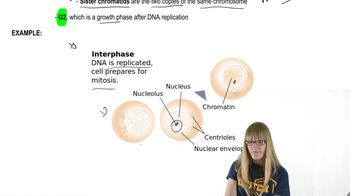From a piece of blank paper, cut out three sets of four cigar-shaped structures (a total of 12 structures). These will represent chromatids. Be sure each member of a set of four chromatids has the same length and girth. In set one, label two chromatids 'A' and two chromatids 'a.' Cut each of these chromatids about halfway across near their midpoint and slide the two 'A' chromatids together at the cuts to form a single set of attached sister chromatids. Do the same for the 'a' chromatids. In the second set of four chromatids, label two 'B' and two 'b.' Cut and slide these together as you did for the first set, joining the 'B' chromatids together and the 'b' chromatids together. Repeat this process for the third set of chromatids, labeling them as 'D' and 'd.' You now have models for three pairs of homologous chromosomes, for a total of six chromosomes. Separate the chromosomes as though meiotic anaphase I and telophase I have taken place.
Table of contents
- 1. Introduction to Genetics51m
- 2. Mendel's Laws of Inheritance3h 37m
- 3. Extensions to Mendelian Inheritance2h 41m
- 4. Genetic Mapping and Linkage2h 28m
- 5. Genetics of Bacteria and Viruses1h 21m
- 6. Chromosomal Variation1h 48m
- 7. DNA and Chromosome Structure56m
- 8. DNA Replication1h 10m
- 9. Mitosis and Meiosis1h 34m
- 10. Transcription1h 0m
- 11. Translation58m
- 12. Gene Regulation in Prokaryotes1h 19m
- 13. Gene Regulation in Eukaryotes44m
- 14. Genetic Control of Development44m
- 15. Genomes and Genomics1h 50m
- 16. Transposable Elements47m
- 17. Mutation, Repair, and Recombination1h 6m
- 18. Molecular Genetic Tools19m
- 19. Cancer Genetics29m
- 20. Quantitative Genetics1h 26m
- 21. Population Genetics50m
- 22. Evolutionary Genetics29m
9. Mitosis and Meiosis
Mitosis
Problem 32d
Textbook Question
From a piece of blank paper, cut out three sets of four cigar-shaped structures (a total of 12 structures). These will represent chromatids. Be sure each member of a set of four chromatids has the same length and girth. In set one, label two chromatids 'A' and two chromatids 'a.' Cut each of these chromatids about halfway across near their midpoint and slide the two 'A' chromatids together at the cuts to form a single set of attached sister chromatids. Do the same for the 'a' chromatids. In the second set of four chromatids, label two 'B' and two 'b.' Cut and slide these together as you did for the first set, joining the 'B' chromatids together and the 'b' chromatids together. Repeat this process for the third set of chromatids, labeling them as 'D' and 'd.' You now have models for three pairs of homologous chromosomes, for a total of six chromosomes. Separate the chromosomes and chromatids as though mitotic anaphase and telophase have taken place.
 Verified step by step guidance
Verified step by step guidance1
Cut out 12 cigar-shaped structures from a piece of blank paper, ensuring that they are of the same size and shape. Divide them into three sets of four chromatids each.
Label the first set of four chromatids as 'A', 'A', 'a', and 'a'. Cut each chromatid halfway across near the midpoint and slide the two 'A' chromatids together to form a pair of sister chromatids. Repeat this process for the 'a' chromatids to form another pair of sister chromatids.
Repeat the same process for the second set of chromatids, labeling them as 'B', 'B', 'b', and 'b'. Join the 'B' chromatids together and the 'b' chromatids together to form two pairs of sister chromatids.
For the third set of chromatids, label them as 'D', 'D', 'd', and 'd'. Join the 'D' chromatids together and the 'd' chromatids together to form two pairs of sister chromatids.
To simulate mitotic anaphase and telophase, separate each pair of sister chromatids into individual chromatids and move them to opposite sides of your workspace. This represents the separation of chromatids into two daughter cells during mitosis.
 Verified video answer for a similar problem:
Verified video answer for a similar problem:This video solution was recommended by our tutors as helpful for the problem above
Video duration:
2mPlay a video:
Was this helpful?
Key Concepts
Here are the essential concepts you must grasp in order to answer the question correctly.
Chromatids
Chromatids are the two identical halves of a replicated chromosome, which are joined together at a region called the centromere. During cell division, specifically in mitosis, chromatids separate to ensure that each daughter cell receives an identical set of chromosomes. Understanding the structure and function of chromatids is crucial for grasping how genetic material is distributed during cell division.
Recommended video:
Guided course

Chromatin
Homologous Chromosomes
Homologous chromosomes are pairs of chromosomes that have the same structure and gene sequence but may carry different alleles. One chromosome of each pair is inherited from each parent. In the context of the question, the sets of chromatids labeled 'A', 'a', 'B', 'b', 'D', and 'd' represent homologous pairs, which are essential for understanding genetic variation and inheritance during meiosis and mitosis.
Recommended video:
Guided course

Chromosome Structure
Mitosis
Mitosis is the process of cell division that results in two genetically identical daughter cells, each with the same number of chromosomes as the parent cell. It consists of several stages, including prophase, metaphase, anaphase, and telophase. The question describes the separation of chromatids during anaphase and telophase, highlighting the importance of these stages in ensuring accurate chromosome distribution.
Recommended video:
Guided course

Mitosis Steps
Related Videos
Related Practice
Textbook Question
385
views


